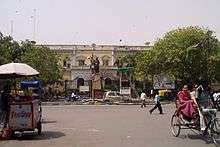Chandni Chowk
| Chandni Chowk | |
|---|---|
| Neighbourhood | |
 Chandni Chowk Location in Delhi, India  Chandni Chowk Chandni Chowk (India) | |
| Coordinates: 28°39′22″N 77°13′52″E / 28.656°N 77.231°ECoordinates: 28°39′22″N 77°13′52″E / 28.656°N 77.231°E | |
| Country | India |
| Union Territory | Delhi |
| District | Central Delhi |
| Metro | Chandni Chowk |
| Languages | |
| • Official | Hindi, Punjabi |
| Time zone | UTC+5:30 (IST) |
| PIN | 110 006 |
| Planning agency | Municipal Corporation of Delhi |
The Chandni Chowk (Moonlight Square) is one of the oldest and busiest markets in Old Delhi, India. Chandni Chowk is located close to Old Delhi Railway Station. The Red Fort monument is located within the market. It was built in the 17th century by Mughal Emperor of India Shah Jahan and designed by his daughter Jahanara. The market was once divided by canals (now closed) to reflect moonlight and remains one of India's largest wholesale markets.[1][2]
History

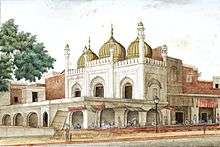
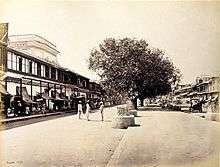
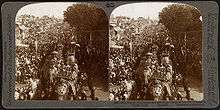
The market's history dates to the founding of the capital city of Shahjahanabad when Emperor Shah Jahan established the Red Fort on the banks of the Yamuna River beside his new capital.
Chandni Chowk, or the Moonlight Square, was designed and established by Princess Jahanara Begum, Shah Jahan’s favourite daughter, in 1650 CE. Originally containing 1,560 shops, the bazaar was 40 yards wide by 1,520 yards long.[3] The bazaar was shaped as a square was given elegance by the presence of a pool in the centre of the complex. The pool shimmered in the moonlight, a feature which was perhaps responsible for its name.[4] Shops were originally built in a half-moon shaped pattern, now lost. The bazaar was famous for its silver merchants, which also have contributed to the name of "Silver Street"[5] as silver is referred to as Chandi in Hindi, a slight variation of which forms Chandni.
The pool in the chowk was replaced by a clock tower (Ghantaghar) until the 1950s. The center of the market is still referred to as Ghantaghar.
Katra Neel is situated between Town Hall to Fatehpuri
Historic Day for India :- On 09 August, 1942, protest was made at historic place outside Katra Neel, Chandni Chowk, Delhi by Sh. Nanak Chand Mishra S/o. Sh.Hanuman Prashad Mishra along with his associates.
During the course of firing, Sh. Nanak Chand Mishra sustained "Bullet Injuries".
Honourable Prime Minister Smt. Indira Gandhi honoured on 15 August, 1972 with “Tamrapatra” to Sh. Nanak Chand Mishra being Freedom Fighter for his struggle in independence of country India
Chandni Chowk was once the grandest Indian market.[6] Mughal imperial processions passed through Chandni Chowk. The tradition was continued when Delhi Durbar was held in 1903. Delhi Town Hall was built in 1863 by the British.
Chandni Chowk runs through the middle of the walled city, from the Lahori Gate of the Red Fort to Fatehpuri Masjid. Originally, a canal ran through the middle of the street. It was initially divided into three sections:[7]
- Lahori Gate to Chowk Kotwali (near Gurdwara Shish Ganj): This section, closest to the imperial residence, was called Urdu Bazar, i.e., the encampment market. The Urdu language got its name from this encampment. Ghalib noted the destruction of this market during the disturbances of the Indian Rebellion of 1857 and its aftermath.
- Chowk Kotwali to Chandni Chowk: The term Chandni Chowk originally referred to the square that had a reflecting pool. This section was originally called Johri Bazar.
- 'Chandni Chowk' to Fatehpuri Masjid: this was called the Fatehpuri Bazar.
Later choked with congestion, the market retains its historical character. The following terms are generally used to describe the buildings and the streets:[8]
- Haveli: a mansion. A normal haveli has a big courtyard (atrium) surrounded on four sides by spacious rooms and often another walled courtyard around the exterior. One of the largest preserved havelis in the area is the Chunnamal haveli.
- Kucha: a zone with houses whose owners shared some common attribute, usually their occupation. Hence the names Maliwara, the gardeners' neighbourhood and Ballimaran, the oarsmen’s neighbourhood.
- Katra: refers to a separate wing of tradesmen and craftsmen belonging to the same trade. They usually lived and worked together. It is a system similar to the guild housing in Amsterdam.
Community
On both sides of the wide Chandni Chowk are historical residential areas served by narrow lanes (gali).
Religious buildings
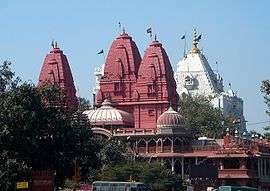

Delhi's most famous mosque, Jama Masjid, built in 1650 in the vicinity, is near famous religious shrines, belonging to multiple religions. Starting from the Red Fort, the buildings include:
- The Sri Digambar Jain Lal Mandir, established in 1656 with a bird hospital established in 1929. A Naya Mandir was built in 1807 in Dharampura, as the first temple with a shikhar.
- The Gauri Shankar Temple[9] was built by a Maratha general Appa Gangadhar in 1761.
- The Shri Shiv Navgrah Mandir Dham[10] (Hindi: श्री शिव नवग्रह मंदिर धाम) is dedicated to Navagraha with the presence of Shiva. The temple's main dham is dedicated to Shri Shani Maharaj Ji. Shri Surya Dev is placed at the top of the main entrance. Shri Sankatmochan Hanuman Mandir and Shri Shakti Mandir are also attached to this temple.
- The Central Baptist Church, built in 1814.
- The Gurdwara Sis Ganj Sahib. The 9th Sikh Guru, Guru Tegh Bahadur and his followers Bhai Mati Das, Bhai Dyal Das and Bhai Sati Das were executed nearby by the Mughals in 1675. The Gurudwaras in the form of memorials were built in 1783 after Delhi, the then Mughal capital, was captured by the Khalsa (the corporate body of Sikhs) under the command of Baghel Singh.
- The Sunehri Masjid was built in 1721 by Roshan-ud-Daula Zafar Khan in the reign of Mohammad Shah. Persian invader Nader Shah spent several hours on the top of the mosque on 11 March 1739 to observe the Katl-e-Aam (the killing of everyone in sight) that he had ordered, which resulted in 30,000 deaths.
- The Fatehpuri Masjid was built by Fatehpuri Begum in 1650, one of the queens of Shah Jahan.
Haveli
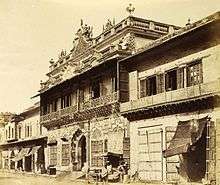
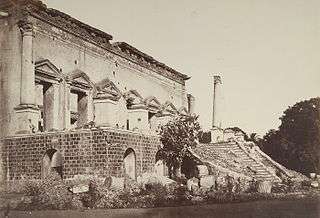
Historic mansions include:[11][12]
- Begum Samru's Palace of 1806 (see [13])now called Bhagirath Palace.
- Naughara mansions in Kinari Bazaar, 18th century Jain mansions. It is a street with nine continuous havelies.
- Khazanchi haveli, khajanchi were the accountants of Shah Jahan. A street is named after them called "Gali Khajanchi", a long underground tunnel connects the haveli and the Red Fort, so that money could be transferred safely.
- Haveli of Mirza Ghalib, Gali Kasim Jan (Gali Ballimaran)
- Chunnamal haveli, Katra Neel
- Haveli of Zeenat Mahal, Lal Kuan Bazar
- Haksar Haveli, Bazar Sitaram, where Jawaharlal Nehru was married in 1916 to Kamla Nehru
- Haveli Naharwali, Kucha Sadullah Khan, where Pervez Musharraf, former president of Pakistan was born
- Haveli Banarsi Bhawan, masjid khazoor, with a water well, situated near to Meru Jain Temple.
- Haveli Dharmpura, Gali Guliyan, designed in late Mughal style although parts show the influence of 20 Century architecture. During Mughal and late Mughal Period, a large numbers of havelis were built by courtiers.[14]
With increasing interest in Old Delhi by Tourist, and to revive the old world charm of Purani Dilli, Haveli Dharmpura houses an Indian restaurant serving specialities of Mughal era with a contemporary touch, which you can enjoy with classical dance.
Shops

Chandni Chowk's speciality is its variety and authenticity: food, delicacies and sweets of more than 1,000 kinds, sarees with chikan and zari. Narrow lanes host shops sell books, clothing, electronic, consumer goods, shoes and leather goods. It is the location of the original Haldiram's and brands such as Gianis. A particular local delicacy are the jalebis, which are fried in pure ghee (clarified butter).
The Cloth Market, supplies home furnishing fabrics, including ready-made items as well as design services. Nai Sarak is the wholesale market of stationery, books, paper and decorative materials. Lal Kuan is a wholesale market for hardware and hotel kitchen equipment. It is adjacent to Tilak Market which is a wholesale market for industrial chemicals. Located at the western end of Chandni Chowk, Khari Baoli is a street entirely dedicated to all kinds of spices, dried fruits, nuts, and herbs. Dariba is the market for silver and gold jewelry. This market also offers trophies, shields, mementos and related items.
Restaurants and eateries
Chandni Chowk is home to several famous restaurants/confectioners (halwais)[15]
- The Ghantewala Halwai, established in 1790.
- Natraj’s Dahi Bhalle, established in 1940.
- The jalebi wala serves city's crispiest jalebis.
- Kanwarji Bhagirathmal Dalbijiwallah established in the mid-19th century.
- Chaatwallah, established in 1923, famous for fruit chaat.
- Bikaner Sweet Shop, famous for rasmalai.
- Gianiji ka Falooda, famous for Rabri Falooda, established around 1947.
- Paranthewali Gali with paratha shops from 1875–1886.[16]
- Meghraj and Sons, since the 1950s
- Chainaram Halwai, established in 1948 serves famous ghee patisa in winter season like none in the city.
- Annapurna Bhandar established in 1929 by Late Mr.Purna Chander Modak [17] is popular for Bengali sweets.
- Tewari Brothers Confectioners, (famous for Motichoor Laddoo, Samosa) established in 1987
- Gol Hatti, established in 1954, serves famous kullhad wale chhole chawal.
Popular culture
Chandni Chowk was featured in the 2001 Bollywood film Kabhi Khushi Kabhie Gham where the leading lady Anjali (Kajol) and her sister Pooja (Kareena Kapoor) lived.
In 2008, The Bollywood movie Black and White starring Anil Kapoor, Anurag Sinha, Shefali Chhaya, and Aditi Sharma is set in Chandni Chowk.
In 2009, The Bollywood movie Chandni Chowk to China starring Akshay Kumar, Deepika Padukone, Mithun Chakraborty, and Ranvir Shorey features some scenes depicting the city.
In 2009, The Bollywood movie Delhi-6 starring Abhishek Bachchan, Sonam Kapoor, Waheeda Rehman, Om Puri, Atul Kulkarni and Divya Dutta had its shooting in the ancient Walled City of Old Delhi, centered around Chandni Chowk.
See also
- Arabber
- Bazaar
- Bazaari
- Dariba Kalan
- Central Baptist Church
- Gali paranthe walee
- Hawker centre (Asia) a centre where street food is sold
- Jainism in Delhi
- Market (place)
- Peddler
- Retail
- Street vendor
- Street food
Further reading
- Delhi, the emperor's city: rediscovering Chandni Chowk and its environs, by Vijay Goel. Lustre Press, 2003. ISBN 81-7436-240-1.
References
- ↑ "Delhi - 100 years as the Capital". The Hindu. 1 February 2011.
- ↑ "Pin Code of Chandni Chowk Delhi". citypincode.in. Retrieved 9 March 2014.
- ↑ Blake, Stephen P. (1998). "Contributors to the urban Landscape: Women builders in Safavid Isfahan and Mughal Shahjahanabad". Women in the medieval Islamic world : Power, patronage, and piety. New York: St. Martin’s Press. p. 420. ISBN 0312224516.
- ↑ http://www.chillibreeze.com/articles/ACulinaryCruise.asp
- ↑ I. Mohan: Delhi, Development and Change, APH Publishing, 2000, Chapter 8, p. 33-35
- ↑ http://www.columbia.edu/itc/mealac/pritchett/00routesdata/1600_1699/shahjahanabad/chandnichauk/chandnichauk.html
- ↑ Encyclopaedic Survey of Islamic Culture: Growth & Development By Mohamed Taher, Anmol Publications, 1998
- ↑ The Havelis, Kuchas and Katras of Chandni Chowk
- ↑ "Gauri Shankar Temple". Archived from the original on 21 July 2011. Retrieved 5 October 2010.
- ↑ http://www.npsin.in/mandir/Shri-Shiv-Navgrah-Mandir-Dham
- ↑ Havelis of Old Delhi/Text by Pavan K. Varma and Sondeep Shankar. Reprint, First published in 1992. New Delhi, Bookwise, 1999
- ↑ Itihas ki dastan hain, Dilli ki havelian http://epaper.hindustandainik.com/blog/uploaded_images/historical_monument_resembles_delhi_haveli-765785.jpg%5Bpermanent+dead+link%5D
- ↑ "Collect Britain has moved". Collectbritain.co.uk. 30 November 2003. Archived from the original on 12 December 2008. Retrieved 30 December 2013.
- ↑ "Haveli to speak of a history lost in time". timesofindia.indiatimes.com. 21 December 2015. Retrieved 21 December 2015.
- ↑ Chowk and cheese http://www.mid-day.com/lifestyle/2008/sep/280908-Features-Sweets-roza-Chandni-Chowk.htm
- ↑ http://www.tribuneindia.com/2002/20021110/spectrum/eat.htm K. R. N. Swamy, Frozen paranthas posing a challenge to Paranthewali Gali fare, The Tribune, 10 November 2002
- ↑ "Annapurna Bhandar Mithai in Chandni Chowk,Delhi/NCR.Annapurna Bhandar Restaurant in Chandni Chowk,Delhi/NCR". Timescity. Retrieved 30 December 2013.
External links
- Shri Digambar Jain Lal Mandir - Having Birds Hospital
- Shri Shiv Navgrah Mandir Dham
- Shri Gauri Shankar Mandir
| Wikimedia Commons has media related to Chandni Chowk. |
- Chandni Chowk's website
- Bhavana Muttreja, Traditional Dwelling Analysis of Chandni Chowk, Archinomy website
